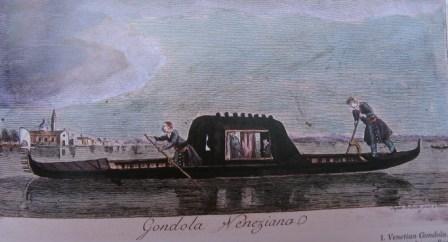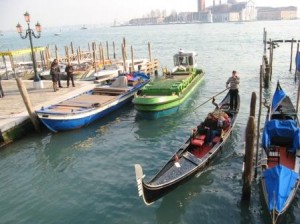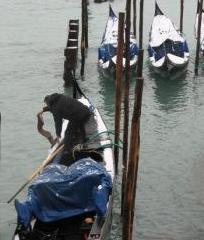
Last Friday an unfortunate event occurred which not only did not shed honor on the worshipful order of gondoliers, it did way, way the opposite, and then some.
The two gondoliers involved have not only been suspended for five days till the jury decides whether to suspend them for three months (“You are so grounded!!”), but three sopping American tourists have been hauled out of the canal, and I think most of their personal effects have been recovered by the fire department divers.

In the early afternoon of the aforementioned Friday, two gondoliers based at the stazio near Piazzale Roma came to blows. I have to say that having heard their location, what followed didn’t come as a total surprise, seeing as the gondoliers here generally are not of the type you can imagine drinking tea with their pinkies extended. It is also fairly evident that conflict between the two men had already been on a low boil for some time now.
Gondolier A was boarding three Americans for a gondola ride. To do this, the gondolier ties his boats to some slim pilings next to a wooden platform with descending steps, and helps the passengers aboard.
Gondolier B approached and, seeing that the embarkation point was occupied and that the people were taking too long (in his opinion) to get aboard, was seized by a fury that impelled him to leap off his boat without even tying it up, and head straight for Gondolier A. The enraged bellowing, threats, imprecations, etc. that flew between the both of them did not need subtitles or any other form of translation; the Americans, seeing an ugly fight approaching, got scared and all stood up together to get off the boat immediately.
Sudden simultaneous movements, which involve weight as well as motion, especially all concentrated on the lower starboard side of a flat-bottomed gondola, are Not Good. The tourists know that now, because suddenly all three were in the drink and one was at least momentarily sort of stuck under the capsized gondola. This is Extremely Not Good.
Happily, at that moment a motor launch was passing, carrying some firemen back to the firehouse. Firemen here are almost always involved in nautical rescues, so they got right to it. People saved, boat righted, sunken objects (including a video camera) eventually retrieved. Gondolier A gets to washing and drying the boat, and peace — or the opposite of rage, anyway — descends.
Needless to say, the Ente Gondola (the gondoliers’ organization) is now taking steps, which will be determined after all the meetings have concluded.
An isolated incident between two men who haven’t had their rabies shots? Not quite, it seems. Because the scene now shifts to Sunday morning (two days later), at the Rialto area.
A batch of us had rowed over from the Lido, as we like to do on Sunday mornings, and had tied up our eight-oar gondola to the platform at the Erbaria, an open sort of small square facing the Grand Canal.
Being a popular tourist area, the Rialto is a place where some gondoliers tie up to await potential clients. Even to entice passersby to become clients. But not today. Enticement was not in the air.
The young gondolier kneeling on the stern wiping down his boat with a chamois cloth suddenly started to roar at a passing tourist who had stopped to make some snaps of him at work. “I’m not paid to be photographed,” the gondolier yelled, using plenty of vulgar phraseology and making some threatening motions that implied he might be ready to come ashore to demonstrate how much he meant it.
The tourist fled. We stood there, aghast. Lino was outraged.
“The gondola and the tourist are a gondolier’s bread,” he said. “If there’s one thing a gondolier depends on, it’s tourists. This shows that not only is he incredibly rude, he’s even willing to shoot himself in the foot.”

Lino wasn’t shouting or gesticulating but I think he was angrier than the gondolier. Because the gondolier was merely responding to some random neural firing somewhere in the limbic system of his brain, whereas Lino felt offended as a Venetian on behalf not only of the gondoliers who aren’t insane, but the image of the city as a whole. It’s painful to him to think that people go away with an idea of his city as a place where you take your life (and your wallet) in your hands.
Let’s see if these two events turn out to have been merely some bizarre coincidence and we can all go back to sleep. Otherwise, I don’t know whether it makes more sense to approach a gondolier wearing a life vest or a bullet-proof jacket.

8 Comments
I’m curious to know how the story of the capsized gondola continues, e.g. what steps (if any) the Ente Gondola will take.
The other event, which you witnessed at the Rialto, is especially disgusting and an ugly surprise.
Maybe gondoliers are fed up now, because lately they got some unpleasant coverage in the media – about their unwillingness to pay the taxes, their not-always-enthusiastic welcoming of women joining their ranks, and now the quarrel between two of them which made the tourists fall into the water.
So, maybe now they have the feeling that tourists are watching them with a kind of suspecting curiosity, rather than admiration and willingness to take a ride.
But this, of course, does not excuse the behavior you described.
It’s difficult — and risky — to try to imagine someone’s thought processes, especially in the collective sense. I don’t know that it’s possible to usefully project much about what “gondoliers” as a group might be thinking or feeling, as they are among the most individualistic people I’ve ever seen. Each one brings to his work his own particular character and world-view, and it’s likely that some are drawn to gondoliering precisely because they can be so independent. To judge what, if anything, tourists may be feeling in their regard, it would be useful to see what kind of reports are being made (if any) in the foreign press about any of this, or if these events haven’t been much heard about beyond the city limits. In any case, I should say that most gondoliers take their work seriously, and if they are beginning to snap under whatever pressures are on them, it can only be exacerbated by the phenomenal heat-and-humidity wave which has been suffocating the city for weeks. Keeping in mind that in summer, they can be working for 15 hours straight. Not an excuse, just an observation.
Seems that what I wrote might be misunderstood…
I didn’t mean to make judgements about a group of people (gondoliers) or another (tourists).
Rather, in an attempt to explain to myself the surprising aggression of that particular person, I referred to a very human behavior which can happen to everyone of us: When we think (no matter why) that another person has an unfriendly attitude towards us, we might be aggressive “in advance”, without a visible reason.
And you’re surely right about the heat.
Of course reality is on 24-hour duty here, like everywhere else, but I hope that despite occasional unfortunate events that gondolas retain their rainbows and romance. I’d hate to see that spoiled, along with so many other things here.
All things considered, I regard gondolas as among the safest vehicles in Venice. I would object to anyone publicizing them as dangerous. Perhaps you don’t keep up with the accidents that the vaporettos are increasingly involved in — a few days ago, one backed up at full speed into a large platform loaded with heavy wooden pilings, and the impact caused a piling to fall in such a way that it sliced through the full length of the interior of the cabin, miraculously not killing anybody. That’s just the latest ACTV adventure. Not as glamorous as gondolas, but clearly a million times more dangerous.